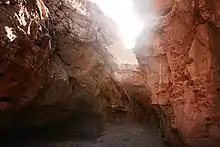Lothagam
Lothagam is a geological formation located in Kenya, near the southwestern shores of Lake Turkana, 55 kilometres from Kanapoi. It is located between the Kerio and Lomunyenkuparet Rivers on an uplifted fault block. [1] Lothagam has deposits dating to the Miocene-Pliocene period and numerous palaeontological finds have been recovered here. Archaeological sites dating to the Holocene are also found at Lothagam, including the Lothagam Lokam[2] harpoon site and the Lothagam North Pillar Site.[3]

Cavern at Lothagam paleontological site in Turkana, Kenya.
Background
Bryan Patterson from Harvard University was, in 1967, the first to carry out paleontological research at Lothagam. [1] Meave Leakey has also carried out extensive paleontological research at Lothagam.[4]
See also
References
- Turkana Basin Institute: Lothagam: about this site Archived 2011-07-28 at the Wayback Machine
- Goldstein, Steven; et al. (2017). "New archaeological investigations at the Lothagam harpoon site at Lake Turkana". Antiquity. 91 (360): e5. doi:10.15184/aqy.2017.215.
- Hildebrand, Elisabeth; et al. (2018). "A monumental cemetery built by eastern Africa's first herders near Lake Turkana, Kenya". PNAS. 115 (36): 8942–8947. doi:10.1073/pnas.1721975115. PMC 6130363. PMID 30127016.
- Leakey, Meave G.; Harris, John M. (2003-01-23). Lothagam : the dawn of humanity in eastern Africa. Leakey, Meave G.,, Harris, John Michael. New York. ISBN 0231507607. OCLC 53119634.
This article is issued from Wikipedia. The text is licensed under Creative Commons - Attribution - Sharealike. Additional terms may apply for the media files.